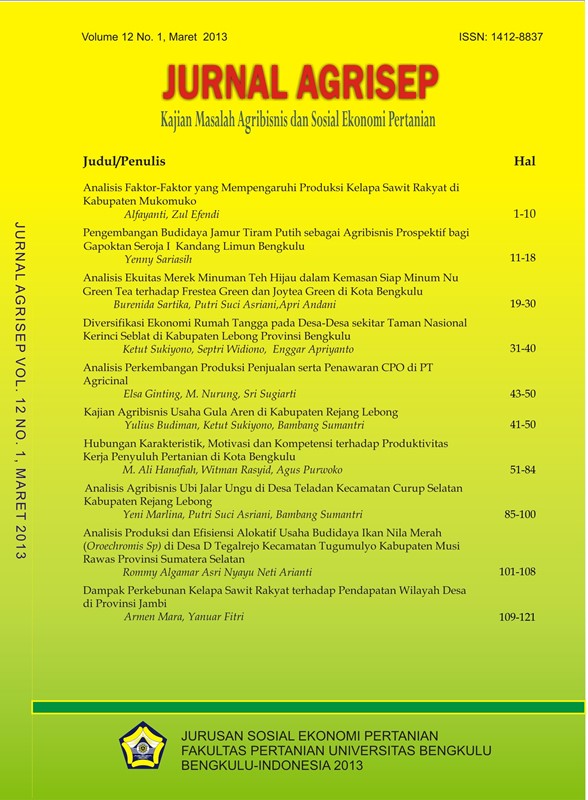Main Article Content
Abstract
Economic diversity has often been promoted as a means to achieve the economic goal of stability. Many empirical studies have also concluded that greater diversification in economic can reduce vulnerability and engendering financial development. The objective of this paper is to analyze the degree of economic diversification at village level. This research was conducted at twenty villages located around Kerinci Seblat National Park (TNKS) and determined purposively and surveyed. Twenty households from each selected village were selected using systematic random sampling method, so the total respondents were 400 households. Economic diversity at the village level was estimated using EDI suggested by Dewi, et al (2005).Research found that EDI value for each village studied varies from 0.20 to 1.00 with no village reaches 1.099, which is an ideal condition. The lowest EDI, i.e. 0.20, occurs in the village of Karang Dapo Atas and Karang Dapo Bawah, subdistrict of Bingin Kuning and the village of Ujung Tanjung II Subdistrict Embong Uram Karang. This value indicates that households in the village surveyed simply rely on one type of work, especially in the agricultural sector. This also means that not many households get into other employment sectors such as mining and or services/stalls/stores. By simply relying on agriculture as its main source of income, households tend to be vulnerable if there is a change in the agricultural sector, especially in sectors such as coffee and rubber plantations.
Keywords
Article Details
Authors who publish with this journal agree with the following terms:
- Authors retain copyright and grant the journal right of first publication with the work simultaneously licensed under a Creative Commons Attribution-ShareAlike 4.0 International License that allows others to share the work with an acknowledgment of the work's authorship and initial publication in this journal.
- Authors are able to enter into separate, additional contractual arrangements for the non-exclusive distribution of the journal's published version of the work (e.g., post it to an institutional repository or publish it in a book), with an acknowledgment of its initial publication in this journal.
- Authors are permitted and encouraged to post their work online (e.g., in institutional repositories or on their website) prior to and during the submission process, as it can lead to productive exchanges, as well as earlier and greater citation of published work (See The Effect of Open Access).
- This work is licensed under a Creative Commons Attribution-ShareAlike 4.0 International License.
References
- Acemoglu, Daron, and Zilibotti, Fabrizo. 1997. Was Prometheus Unbound by Chance? Risk, Diversification, and Growth. Journal of Political Economy, 105(4): 709 – 51.
- Attaran, M., 1987. Industrial Diversity and Economic Performance in US Areas. Annuals of Regional Science. XX: 44-54.
- Dewi, Sonya, Brian Belcher And Atie Puntodewo. 2005. Village Economic Opportunity, Forest Dependence, And Rural Livelihoods In East Kalimantan, Indonesia. World Development. 33 (9): 1419–1434.
- Kort, J.R. 1981. "Regional Economic Instability and Industrial Diversification in the US". Land Economics. 57(4): 596-608.
- Malizia EE, and Ke S. 1993. The influence of economic diversity on employment and stability. J Reg. Sci. 33(2): 221–235.
- Moore, E. 2001. Measuring Economic Diversification. Oregon Employment Department, USA, diunduh dari: www.co.lane.or.us/Departments/CAO/EconomicDevelopment/Doc
- uments/Measuring_Economic_Diversification.pdf pada tanggal 5
- Oktober 2012 jam 10.00.
- Saint-Paul, Gilles. 1992. Technological Choice, Financial Markets and Economic Development. European Economic Review. 4(36): 763-781.
- WALHI BENGKULU. 2008. Kerusakan Hutan Taman Nasional Kerinci Sebelat Wilayah Kabupaten Lebong, Propinsi Bengkulu. Diunduh dari http://cfors.wordpress.com/2008/03/14/kerusakan-hutan-tamannasional-kerinci-sebelat-wilayah-kabupaten-lebong-propinsibengkulu. pada tanggal 17 Juli 2011, jam 11.00.
References
Acemoglu, Daron, and Zilibotti, Fabrizo. 1997. Was Prometheus Unbound by Chance? Risk, Diversification, and Growth. Journal of Political Economy, 105(4): 709 – 51.
Attaran, M., 1987. Industrial Diversity and Economic Performance in US Areas. Annuals of Regional Science. XX: 44-54.
Dewi, Sonya, Brian Belcher And Atie Puntodewo. 2005. Village Economic Opportunity, Forest Dependence, And Rural Livelihoods In East Kalimantan, Indonesia. World Development. 33 (9): 1419–1434.
Kort, J.R. 1981. "Regional Economic Instability and Industrial Diversification in the US". Land Economics. 57(4): 596-608.
Malizia EE, and Ke S. 1993. The influence of economic diversity on employment and stability. J Reg. Sci. 33(2): 221–235.
Moore, E. 2001. Measuring Economic Diversification. Oregon Employment Department, USA, diunduh dari: www.co.lane.or.us/Departments/CAO/EconomicDevelopment/Doc
uments/Measuring_Economic_Diversification.pdf pada tanggal 5
Oktober 2012 jam 10.00.
Saint-Paul, Gilles. 1992. Technological Choice, Financial Markets and Economic Development. European Economic Review. 4(36): 763-781.
WALHI BENGKULU. 2008. Kerusakan Hutan Taman Nasional Kerinci Sebelat Wilayah Kabupaten Lebong, Propinsi Bengkulu. Diunduh dari http://cfors.wordpress.com/2008/03/14/kerusakan-hutan-tamannasional-kerinci-sebelat-wilayah-kabupaten-lebong-propinsibengkulu. pada tanggal 17 Juli 2011, jam 11.00.
